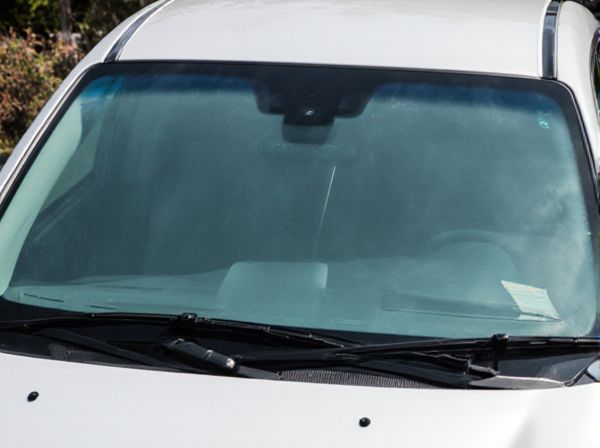
Photo illustration: Infrared-Absorbing Windshield vs UV-Blocking Windshield
An infrared-absorbing windshield effectively reduces heat buildup inside your vehicle by blocking infrared rays, enhancing comfort on sunny days. A UV-blocking windshield protects your skin and interior materials from harmful ultraviolet rays, preventing sun damage and fading. Choosing the right windshield depends on whether your priority is heat reduction or UV protection for your driving experience.
Table of Comparison
| Feature | Infrared-Absorbing Windshield | UV-Blocking Windshield |
|---|---|---|
| Primary Function | Reduces infrared heat transmission to keep cabin cooler | Blocks ultraviolet (UV) rays to protect skin and interior |
| Heat Reduction | High - significantly lowers solar heat gain | Moderate - limits UV heat but less impact on infrared heat |
| UV Protection | Partial - reduces some UV rays | Complete - blocks up to 99% of UV-A and UV-B rays |
| Impact on Visibility | Minimal - maintains clear visibility | Minimal - transparent to visible light |
| Common Uses | Preferred for heat-sensitive climates | Ideal for UV protection and skin health |
| Cost | Moderate to high | Moderate |
| Durability | Long-lasting with consistent heat reduction | Long-lasting UV blocking efficiency |
Introduction to Automotive Windshield Technologies
Infrared-absorbing windshields use specialized coatings to reduce heat buildup by blocking infrared radiation, enhancing cabin comfort and reducing the load on air conditioning systems. UV-blocking windshields incorporate laminated glass layers embedded with ultraviolet inhibitors to protect passengers from harmful UV rays and prevent interior fading. Both technologies improve vehicle safety and comfort, but infrared-absorbing glass primarily targets thermal regulation, while UV-blocking glass focuses on radiation protection.
What is an Infrared-Absorbing Windshield?
An infrared-absorbing windshield is engineered with special coatings or embedded materials that selectively absorb infrared radiation, reducing heat transfer into the vehicle cabin and enhancing occupant comfort. Unlike UV-blocking windshields that primarily filter ultraviolet rays to prevent skin damage and interior fading, infrared-absorbing windshields effectively minimize solar heat buildup, improving energy efficiency by reducing the load on air conditioning systems. This technology helps maintain cooler interior temperatures without compromising visibility or safety standards.
Understanding UV-Blocking Windshields
UV-blocking windshields are designed with advanced laminated glass containing special interlayers that absorb harmful ultraviolet rays, effectively protecting vehicle occupants from UV exposure. These windshields reduce skin damage and interior fading by blocking up to 99% of UVA and UVB radiation without compromising visibility. Unlike infrared-absorbing windshields, UV-blocking glass primarily targets ultraviolet light while allowing heat transmission control to be managed by other vehicle components.
Heat Reduction: IR-Absorbing vs UV-Blocking
Infrared-absorbing windshields significantly reduce heat buildup inside a vehicle by blocking infrared radiation, which is the primary source of thermal energy from sunlight. UV-blocking windshields mainly protect against ultraviolet rays, which cause skin damage and interior fading but contribute minimally to heat reduction. Therefore, for effective heat management, infrared-absorbing technology offers superior temperature control compared to UV-blocking windshields.
UV Protection and Interior Preservation
Infrared-absorbing windshields primarily reduce heat buildup inside the vehicle by blocking infrared radiation, which helps prevent interior materials from degrading due to high temperatures. UV-blocking windshields effectively filter out harmful ultraviolet rays, significantly reducing the risk of fading and cracking in upholstery, dashboard, and other interior components. Combining both technologies offers comprehensive protection by minimizing UV damage and thermal stress, thereby preserving the vehicle's interior condition over time.
Energy Efficiency and Cabin Comfort
Infrared-absorbing windshields significantly reduce heat transfer from sunlight, lowering the need for air conditioning and enhancing energy efficiency by minimizing fuel consumption or battery drain in electric vehicles. UV-blocking windshields primarily protect occupants from harmful ultraviolet rays, preserving cabin materials and skin health without directly impacting thermal management. Combining both technologies offers optimal cabin comfort by maintaining lower interior temperatures and shielding passengers from UV radiation, contributing to improved overall vehicle efficiency and occupant well-being.
Comparative Cost and Installation Differences
Infrared-absorbing windshields typically incur higher costs due to advanced coatings designed to reduce heat transfer, whereas UV-blocking windshields are generally more affordable with widespread availability. Installation of infrared-absorbing windshields often requires specialized handling to preserve coating integrity, increasing labor expenses, while UV-blocking windshields ease installation with standard procedures. The price variance reflects both material technology and complexity in installation, influencing overall vehicle upgrade budgets significantly.
Longevity and Maintenance Considerations
Infrared-absorbing windshields reduce heat buildup inside vehicles, protecting interior components like dashboards and upholstery from sun damage, which extends their lifespan and decreases maintenance costs related to fading and cracking. UV-blocking windshields primarily shield against ultraviolet radiation, preventing skin damage and reducing interior discoloration but may offer less thermal protection compared to infrared-absorbing variants. Choosing an infrared-absorbing windshield enhances longevity by maintaining a cooler cabin environment, resulting in lower energy consumption for air conditioning and less frequent interior repairs or replacements.
Safety Impacts of Advanced Windshields
Infrared-absorbing windshields enhance vehicle safety by reducing heat buildup inside the cabin, minimizing driver fatigue and improving comfort during long drives. UV-blocking windshields protect occupants from harmful ultraviolet radiation, preventing skin damage and reducing the risk of eye-related health issues. Both technologies contribute to advanced windshield safety by maintaining clearer visibility and preserving the integrity of interior materials under prolonged exposure to sunlight.
Choosing the Right Windshield for Your Vehicle
Choosing the right windshield for your vehicle involves understanding the benefits of Infrared-Absorbing versus UV-Blocking windshields. Infrared-Absorbing windshields reduce heat buildup by filtering infrared rays, enhancing cabin comfort and lowering air conditioning use. UV-Blocking windshields protect occupants and interior materials from harmful ultraviolet radiation, preventing skin damage and fading of upholstery.
 caratoz.com
caratoz.com